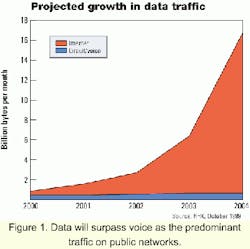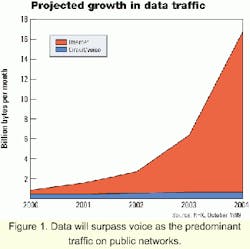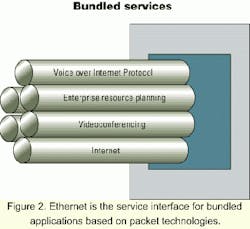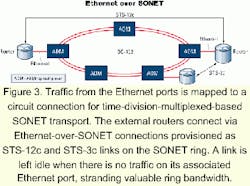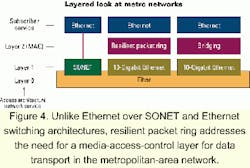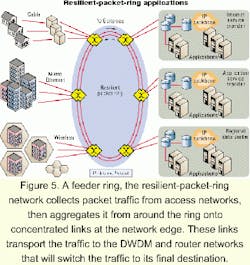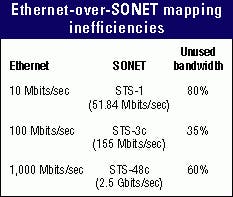Resilient packet rings for optical Internet edge
Packet rings will be used much like SONET collector rings today, but for packet-based network traffic.
BOB SCHIFF and KANAIYA VASANI,
Lantern Communications Inc.
In the mid-1990s, two disruptive changes unsettled the communications market; one was the deregulation of the telecommunications industry and the second was the explosive growth of the Internet. Together, these developments have fundamentally altered the landscape. An industry, once considered mature and stable, is being redefined and shaped by a wave of innovative activity.
A well-accepted projection is that packet traffic will become the predominant consumer of network bandwidth within the next several years (see Figure 1). That's a direct consequence of the migration of business applications and information content onto the network. Networks have evolved beyond their simpler transport roots, emerging as strategic assets to businesses and fundamental enablers of the new economy.
The use of time-division multiplexing (TDM) infrastructure to carry packet traffic made sense when circuit applications represented a majority of the traffic in the network. Not anymore. What's needed is a more data-friendly architecture in the metro, one that offers the reliability of SONET but is optimized for packet-based applications and service delivery.
Most networks today are built from a mix of network services that include private lines, ATM, and frame relay. While adequate for the data needs of the past, these services do not offer the scalability or achieve the cost points required to meet the market demands of the Internet-enabled economy. ATM and frame relay services are offered at monthly rates that exceed $600 per Mbit/sec, which is cost-prohibitive for most customers at rates >45 Mbits/sec. Symmetric DSL services, on the other hand, are priced at roughly $300 per Mbit/sec per month, but do not scale beyond 1.5 Mbits/sec. With growing customer demand for affordable network access at speeds of 10 Mbits/sec, 100 Mbits/sec, and more, there's a clear need for a new class of data service that's more scalable and cost-effective than what's available today.Fortunately, companies will not have to look far to find an answer. Corporations have been building their internal networks using this technology for years. It has soundly defeated all other competing technologies in its space. The technology is Ethernet, and it's poised to become the universal service interface to the WAN.
There are few technologies that can compare to Ethernet in their ability to evolve and adapt. Ethernet's longevity and durability are a testament to the elegance of the original concept and the effectiveness of the industry to evolve the technology to meet the needs of its newest users, while preserving compatibility with its enormous installed base.Ethernet has changed significantly from how it began more than 20 years ago, when it was introduced to the market as a shared half-duplex 10-Mbit/sec LAN technology. It is now a full-duplex technology that supports speeds from 10 Mbits/sec to 1,000 Mbits/sec over copper and fiber media to distances of more than 60 km. The standardization of 10-Gigabit Ethernet is well underway scaling this adaptable technology yet another order of magnitude.
Ethernet's flexibility and low cost combined with its familiarity and ease of use have enabled it to dominate the LAN landscape with 95% of the installed base. This success is expected to spill over into the WAN. Ethernet-based services will be the successor to ATM and frame relay services in metropolitan-area networks (MANs).
Indeed, the introduction of metro Ethernet services has already begun with next-generation Ethernet local-exchange carriers (ELECs) deploying access networks based on Ethernet Layers 2 and 3 switching products. One of these providers is offering Ethernet service for $1,000 per 100 Mbit/sec-compare that to ATM or frame relay.
Using Ethernet as a service interface has a number of benefits. Subscribers do not have to deal with technologies other than the familiar Ethernet. It is also a more cost-effective solution, because it eliminates the need for expensive V.35 interfaces in access routers and demarcation equipment such as T1, frame relay, and ATM channel service units. With an Ethernet access service, the customer's access router can connect directly to the service through one of its native Ethernet ports.Scalability is another advantage. A service provider can drop a Fast Ethernet (100-Mbit/sec) or Gigabit Ethernet (1,000-Mbit/sec) port to a subscriber once and upgrade many times, without additional truck rolls beyond the initial installation. Bandwidth and other service changes can be administered remotely, simplifying and facilitating service provisioning.
Ethernet also has the ability to support integrated access applications when delivered over the right infrastructure. As competition intensifies, service providers are looking for ways to differentiate their services. An integrated service offering is one such offering. With so many applications now based on packet techniques and technologies such as Internet Protocol (IP), Ethernet becomes the natural service interface for these bundled services (see Figure 2).
With so many promising attributes, it's no wonder Ethernet is being viewed as the universal information plug for the future. The issue for service providers is the infrastructure on which to deploy these Ethernet services. Prominent among the options are SONET add/ drop systems and switched packet solutions based on Ethernet switches or resilient packet rings (RPRs), an emerging architecture for MANs.
The attributes that made SONET such an attractive technology in the circuit era make it less so in the packet era. Specifically, SONET's framing structure defines coarse payload increments and does not lend itself to the fine granularity nature of data flows. Although it is well suited for transporting and multiplexing circuit services, SONET's payload structure and circuit-based hierarchy is not an efficient scheme for transporting packet traffic. To support a Fast Ethernet connection over a SONET link, an entire STS-3c payload (155 Mbits/sec) is consumed for this bursty 100-Mbit/sec service. Needless to say, that is not an efficient use of bandwidth.
SONET's restoration scheme requires that a fiber ring be available in a hot standby mode; therefore, it is not available to carry traffic under normal operating conditions. While this protection technique makes sense for constant-rate, full-period traffic, it is not an efficient way to handle service protection for data traffic. An efficient protection scheme for packet traffic would take advantage of the statistical nature of the traffic and not require that an entire ring be held in reserve.Another important aspect of SONET is its circuit-based provisioning model. The network operator establishes a point-to-point circuit by identifying the circuit's physical endpoints to the management system. The management system in turn determines and configures all intermediate through-connections that need to be made. In older SONET systems, the provisioning process requires many steps. The network operator must configure each node within the ring for all the required pass-through and add/drop connections. This provisioning operation is time- and labor-intensive. Often, a technician must be sent into the field to install the OC-3c (155-Mbit/sec) or OC-12c (599.04-Mbit/sec) add/drop-multiplexing module needed to support the requested circuit.
To facilitate connections with data-networking equipment such as routers, the new generation of SONET equipment supports Ethernet service ports. Traffic from these Ethernet ports is simply mapped to a circuit connection across the ring. The underlying SONET transport remains circuit-oriented and TDM-based. Figure 3 illustrates such a network. External routers connect through this network via Ethernet-over-SONET connections, which are provisioned as STS-12c and STS-3c links on the SONET ring. A link is left idle when there is no traffic on its associated Ethernet port, stranding valuable ring bandwidth.
The mapping of Ethernet traffic to SONET is very inefficient. A Gigabit Ethernet service mapped to an STS-48c (2.5-Gbit/sec) payload results in 60% stranded bandwidth. The Table on page 188 shows the inefficiencies associated with mapping Ethernet services to various SONET payloads.
To avoid some of these inefficiencies, newer SONET solutions incorporate a packet switch in addition to a TDM crossconnect. The packet switch improves bandwidth utilization by multiplexing multiple Ethernet interfaces onto one STS-N connection. Some solutions offer configurable concatenation allowing, for example, a Gigabit Ethernet service to be mapped to two concatenated STS-12c (1.24-Gbit/sec) connections.
From a networking perspective, the integral packet switch operates as a bridge or router. If the switch operates as a bridge, the system performs as a network of bridges interconnected by a mesh of STS-N circuits. The bandwidth for the STS-N connection between any two bridges is carved out of the SONET ring and cannot be reused even if there's no traffic flowing between the bridges. Moreover, the computation of a spanning tree will result in certain paths being blocked, creating more unused bandwidth.
If the packet switch operates as a router, the system performs as a network of routers interconnected by a mesh of STS-N circuits. Traffic is routed at every transit node before it egresses the ring-a process that's highly inefficient, adds unnecessary complexity, and adversely affects network performance. Even though packet switching improves the efficiency of packing data onto SONET, the underlying transport remains circuit-oriented.Next-generation SONET is a symptomatic solution. It attempts to improve SONET's data-carrying efficiency but fails to address the basic problem, which is the continued use of TDM technology to accommodate the explosive growth in data traffic.
What's required is a more fundamental solution to the disruptive changes taking place in the market. The common thread underlying all these changes is that data traffic, not circuit traffic, is the most significant component of communications networks.
Ethernet-switch vendors have leveraged recent advances in Ethernet, including the development of Gigabit Ethernet and long-reach Ethernet components, to deploy switched Ethernet solutions in metropolitan networks.
Although Ethernet switch solutions have the appeal of low cost and data focus, these solutions are not optimized for the ring topology that dominates metro networks, nor do they support the levels of survivability or service-level guarantees expected of public-network infrastructure. Recovery from network faults could take tens of seconds versus the 50-msec performance of SONET networks.Additionally, Ethernet switches lack the ability to support deterministic and verifiable service-level agreements. As frames get switched a node at a time, there are no mechanisms to guarantee delay and jitter across multiple switches configured in either a ring or mesh topology.
While there are a number of Ethernet-switch products that can prioritize data on ingress and shape and schedule traffic on egress per defined policies, these products do not have an edge-to-edge view of quality of service (QoS). Ethernet switches may provide a certain level of QoS through the device, but there is little, if any, coordination of QoS service between devices. In a network consisting of two or more switches, this lack of network-wide QoS control precludes support for edge-to-edge QoS.
Ethernet switches are not the answer to building a scalable metro network that delivers the resilience, performance, and deterministic service required of public-network infrastructure. There's a compelling need for a new architecture for metropolitan packet networks-one that combines the resilience and deterministic performance of SONET and the data friendliness of Ethernet switches.
Resilient packet ring (RPR) is an emerging network architecture and technology designed to meet the requirements of a packet-based MAN. An RPR network is a ring-based architecture that consists of packet-switching nodes connecting to adjacent nodes over a single fiber pair. The network topology is based on dual counter-rotating rings. The internodal links are fiber-based and may employ WDM to scale the capacity of the ring.
The IEEE 802.17 Resilient Packet Ring Working Group is developing standards in this area. The working group is establishing standards for a media-access-control (MAC) layer for data transport on a metropolitan-area ring network-the first time the industry is defining a metro architecture optimized for packet-based services.
Transporting packets across a shared medium is a problem typically handled at the MAC layer of a protocol stack. By controlling access to the medium-a 10-Gbit/sec optical ring, for example-and arbitrating requests for its use, the MAC layer is able to guarantee service quality (i.e., delay and jitter) and bandwidth management. In addition, the RPR's MAC implements a service-protection mechanism to guard against ring failures and a congestion-avoidance scheme that enables the system to operate near full-capacity while ensuring QoS to all configured services.
Neither SONET nor Ethernet switching addresses the need for a MAC layer designed for the metropolitan-area environment (see Figure 4). SONET employs Layer 1 techniques for bandwidth management and service protection. Ethernet switches rely on Ethernet bridging or IP routing for bandwidth management and service protection.
Consequently, the network is either underutilized in the case of SONET or non-deterministic in the case of Ethernet switches.
RPR addresses these shortcomings by defining a MAC layer optimized for MANs that provides the resilience, deterministic service, and manageability required of next-generation access networks.
RPR networks will be used as feeder rings in the metro. These feeder rings, also known as collector rings, will be used in much the same way as SONET rings today, but for packet traffic. Packet access networks such as cable-modem systems and fixed wireless networks will feed RPR networks (see Figure 5). The RPR network aggregates the packet traffic from around the ring onto one or more highly concentrated links connecting to the network edge. At the network's edge, these links are the handoffs to the DWDM and router networks that switch the traffic to its final destination.
RPR access rings may be implemented as an overlay network, utilizing fiber strands that, in many instances, run side-by-side the fiber facilities carrying circuit traffic (i.e., SONET/SDH links).
The existing SONET infrastructure will continue to be used for the services it was designed for: private lines, circuit-switched voice, circuit-switch ed data, and network access for narrowband and wideband data virtual-private-network services such as frame relay and ATM.
As the number of service providers grows, there is increasing pressure on the pricing of network services and particularly network bandwidth. To compete effectively in this environment, service providers must implement a network architecture that satisfies this demand and facilitates operational efficiency, customer responsiveness, and service differentiation.
At the network's edge, there is no better architecture for creating this competitive advantage than RPRs. Offering carrier-class reliability, optimized packet transport, and point-to-point and multipoint services, RPR networks can provide network operators with a reliable, cost-effective, and flexible edge infrastructure on which to deliver advanced services.
The introduction of 10-Gbit/sec RPRs into the MAN will enable an array of new data services at price points and bandwidth efficiencies not possible with circuit-centric solutions. RPR networks will play an important role in the evolution of the public network, providing a scalable and efficient packet edge for the emerging optical Internet.
Bob Schiff is senior marketing director and Kanaiya Vasani is marketing director at Lantern Communications Inc. (San Jose, CA).
